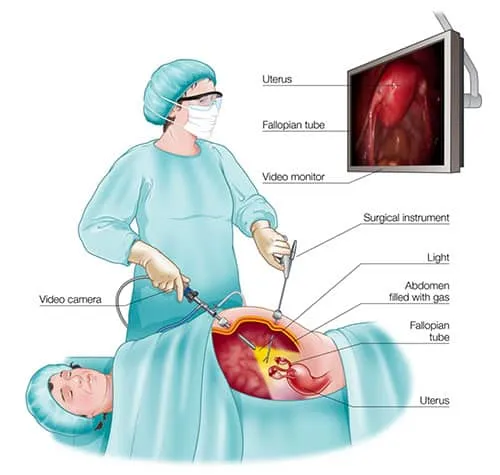What is a laparoscopy?
Laparoscopy is a surgical procedure used to examine the organs in the belly (abdomen). It can also examine a woman’s pelvic organs.
Laparoscopy uses a thin lighted tube that has a video camera. The tube is called a laparoscope. It is put into a tiny cut (incision) in your belly. The video camera images can be seen on a computer screen.
One benefit of laparoscopy is that it is minimally invasive. That means it uses a very small cut (incision) in the belly. Laparoscopy often takes less time and has a faster recovery than open (traditional) surgery.
Laparoscopy may be used to take a small tissue sample for testing (a biopsy). It can also be used to remove organs, such as the appendix (appendectomy) or the gallbladder (cholecystectomy). |

|
Why might I need a laparoscopy?An abdominal laparoscopy is sometimes called a diagnostic laparoscopy. It can be done to examine the abdomen and its organs for:
· Tumors and other growths
· Injuries
· Bleeding inside the belly
· Infections
· Pain that can’t be explained
· Blockages
· Other conditions
A diagnostic laparoscopy is often done when the results of a physical exam, X-ray, or CT scan aren't clear. Or it may be done when more information is needed.
Laparoscopy may be used to figure out the stage of cancer for an abdominal organ. It may also be used to find where and how deep an abdominal injury is. It can also see how much internal bleeding you have.
For women, a gynecologic laparoscopy may be used to check:
· Pelvic pain and problems
· Ovarian cysts
· Fibroids
· The fallopian tubes
Laparoscopy can also be used to diagnose and treat endometriosis. This is when tissue that normally lines the uterus grows outside it. Laparoscopy may be done to treat an ectopic pregnancy or to do a tubal ligation (tie the fallopian tubes) to permanently prevent pregnancy.
Laparoscopy can also be used to do bariatric surgery, such as gastric bypass or gastric sleeve. These procedures have become more common in treating obesity.
There may be other reasons for your healthcare provider to suggest a laparoscopy.
What happens after a laparoscopy?After surgery, you'll be taken to the post-anesthesia care unit (PACU). Your recovery process will vary depending on the type of anesthesia you had. You'll be watched closely. Once your blood pressure, pulse, and breathing are stable and you're alert, you'll be taken to your hospital room. Or you may be sent home if this was an outpatient procedure.
When you're home, you must keep the cut clean and dry. Your healthcare provider will give you instructions on how to wash. Any stitches or surgical staples will be taken out at a follow-up office visit. If adhesive strips were used, they should be kept dry. They'll often fall off in a few days.
You may feel pain from the carbon dioxide gas still in your belly. This pain may last for a few days and may be felt in your shoulders. It should feel a bit better each day. You may take a pain medicine as directed by your provider. Aspirin or other pain medicines may raise your risk of bleeding. Only take medicines that your provider has approved.
Use a bowel regimen, if advised, to keep your bowels moving. This is especially important if you're taking pain medicines, which often cause constipation.
Don’t have any carbonated drinks for 1 or 2 days after the procedure. This will help reduce the discomfort from the carbon dioxide gas. Also, carbonated drinks may upset your stomach.
You may be allowed to drink clear fluids a few hours after the procedure. You may slowly move on to more solid foods as directed. Tell your healthcare provider if you have nausea or vomiting.
You may be told to limit your physical activity for a few days.


